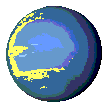Appendices
The Chaos Hypertextbook™
© 1995-2003 by Glenn Elert
All Rights Reserved -- Fair Use Encouraged
prev | index | next
A.1 Annotated Bibliography of Print Resources
There are thousands of printed resources on chaos, fractals, and dimension.
These are the sources that inspired me to write this book.
- Barnsley, Michael. Fractals Everywhere. San Diego, CA: Academic Press,
1988.
If you want to really learn about fractals, this is the textbook I recommend.
Easy to read.
- Devaney, Robert L. "Overview:
Dynamics of Simple Maps" Chaos and Fractals: The Mathematics Behind
the Computer Graphics. Robert L. Devaney & Linda Keen, eds. Providence,
RI: American Mathematical Society, 1988.
- Dewdney, A. K. "Mathematical
Recreations: Leaping into Lyapunov Space" Scientific American.
September 1991: 178-180. [alternate url]
- Gleick, James. Chaos: Making a New Science. New York: Viking, 1987.
More of a history lesson than a mathematics lesson. The companion
DOS software package (which I have not reviewed) is still available as
shareware from San José State University.
- Harrison, Jenny. "An Introduction to Fractals" Chaos and Fractals:
The Mathematics Behind the Computer Graphics. Robert L. Devaney &
Linda Keen, eds. Providence, RI: American Mathematical Society, 1988, 107-126.
A technical and readable introduction to fractals. The author mentions a study
done by Tricot on "12 definitions of dimension".
- Tricot, C. "Douze definitions de la densité logarithmique."
C. R. Acad. Sci. Paris Sér. I Math. 293 (1981), 549-552.
- Tricot, C. "Two [sic?] Definitions of Fractional Dimension."
Mathematical Proceedings of the Cambridge Philosophical Society.
91 (1982): 57-74.
- Hocking, John G. & Young, Gail S. Topology. New York: Dover,
1961.
Gail S. Young was my topology professor at Columbia University. The Dover
reprint of this textbook is wonderfully inexpensive. I can easily recommend
it for its price alone (something around US $9 in 1995).
- Hofstadter, Douglas R. Metamagical Themas: Questing for the Essence of
Mind and Pattern. New York: Basic Books, 1985.
This was my first introduction to the world of chaos. The description is amazingly
simple, but the conclusions are profound. By just goofing around with the
parabola, one can generate an entirely new field of mathematics. How amazing
is that?
- Hurewicz, Witold & Henry Wallman. Dimension Theory. Princeton,
NJ: Princeton University Press, 1941.
References to this book appeared throughout my research. It is currently out
of print and I have not read it.
- Hubbard, John Hamal (Dynamical Systems Laboratory). Mandelbrot Sets and
Julia Sets. Videocassette. Ithaca, NY: Art Matrix: 1990.
Two hours of supercomputed fractal animation with a soundtrack that varies
from new age to techno. No discussion or commentary, just animations. Includes
Mandelbrot zooms, Julia promenades, cascade maps, and the Lorenz attractor.
This videocassette is probably out of print. The distributor doesn't even
sell fractal products anymore. (Fractals just weren't a good money maker I
was told.) A somewhat obsolete product given that nearly all of these images
can now be generated on a personal computer.
- Jones, Jesse. Fractals for the Macintosh. Corte Madera, CA: The Waite
Group, 1993.
An inexpensive little book and CD combination that is now out of print. Fractals
for the Macintosh disappeared along with the company that published it.
- Keen, Linda "Julia Sets" Chaos and Fractals: The Mathematics
Behind the Computer Graphics. Robert L. Devaney & Linda Keen, eds.
Providence, RI: American Mathematical Society, 1988, 57-74.
- Kline, Morris. Mathematical Thought from Ancient to Modern Times.
New York: Oxford University Press, 1972.
- Lauwerier, Hans. Fractals: Endlessly Repeated Geometrical Figures.
translated by Sophia Gill-Hoffstädt. Princeton, NJ: Princeton University
Press, 1991.
- Mandelbrot,
Benoit B. The Fractal Geometry of Nature. revised edition. New
York: W. H. Freeman and Company, 1977.
The book that introduced the Mandelbrot set (called the mu-set). Wanders around
a bit, but very entertaining. Hundreds of examples are included.
- Markus, Mario. "Chaos in Maps with Continuous and Discontinuous Maxima"
Computers in Physics. September/October 1990: 481-493.
The original article on the Lyapunov space diagrams featured in Chapter
4.4.
- Nicolis, Grégoire & Prigogine, Ilya. Exploring Complexity:
An Introduction. New York: Freeman, 1989.
- Peitgen, H. O., H. Jürgens, D. Saupe, & C. Zahlten. Fractals:
An Animated Discussion. Videocassette. New York: Freeman, 1990.
A good non-technical overview of chaos and fractals featuring interviews with
Mandelbrot and Lorenz. Their discussions are somewhat animated, but the narrator
speaks like a hypnotist. (The chaotic background music doesn't help in this
matter.) Not suitable for people with short attention spans. I liked it however.
- Penrose, Roger. The Emperor's New Mind. New York: Oxford University
Press, 1989.
- Pickover, Clifford
A. Chaos in Wonderland: Visual Adventures in a Fractal World. New
York: St Martin's, 1995.
Relevant excepts from this book can be found in the chapter The
15 Most Famous Transcendental Numbers.
- Pickover, Clifford
A. "The World of Chaos" Computers in Physics. September/October
1990: 460-487.
- Symon, Keith R. Mechanics. 3rd edition. Reading, MA: Addison Wesley,
1971.
My undergraduate mechanics textbook and the resource I used to remind myself
of all the mathematics behind the harmonic oscillator.
prev | index | next

